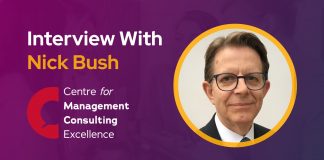Hi Mark, tell us about yourself and your background.
I have spent the majority of my career in the CX consulting space; I’ve been privileged to work with some of the best companies the world has to offer (firms like Lenovo, Cisco Systems, Dun & Bradstreet, and IHS, just to name a few). I came into consulting a bit by accident – in college, I found that I have a love for numbers and statistics, and I was fortunate to land my first post-college job in the market research space. At the time, CX was just beginning to take shape, so I was able to get into CX in its nascent stage. Since that time, I have been able to achieve the CCXP certification, and I’m humbled to serve on the board of directors for the Customer Experience Professionals Association (CXPA). Over the years, I’ve cultivated an interest and expertise in being able to demonstrate the connection between CX and firm financial performance. Though many find the linkage between CX and financial success to be elusive, I can assure you that it can be accomplished.
What is the biggest misunderstanding about customer experience, in your opinion?
There is a tendency to think of CX and Voice of Customer (VoC) as one and the same. Many cannot separate VoC from CX, and this is problematic for a couple of reasons – first, it limits CX to a survey-oriented approach. The reality is that in order to understand the dynamics of CX, you have to be using a wide variety of data – survey, operational, financial, and other unsolicited sources (social, rating, site data, etc.). Above and beyond this, conflating CX and VoC diminishes the broad set of skills that successful practitioners must have to master CX – you certainly need hard quant skills, but you also need to be conversant in sales and marketing, finance, operations, customer support – all aspects of the business. In addition, you need to have a wide arsenal of tools and skills, such as the ability to influence/persuade, manage change, develop and implement action plans, and – above all else – be able to communicate complex concepts in a straightforward manner. As I often tell clients and prospects – VoC is a component of CX, but it is not the entirety of CX.
What are some of the newer CX companies/solutions you’re keeping your eyes on right now?
I am biased, but I’m bullish on our company, Forsta. While Forsta is new, it’s not entirely a new company – it’s a combination of three powerhouse brands in Confirmit, FocusVision, and Dapresy that is bringing together quant, qual, and reporting in a way that will help bring clarity and understanding to decision-makers. By having a full suite of tools in our arsenal, coupled with our service capabilities and focus on CX/EX, we are poised to address CX in a way that is unparalleled.
What can companies do to improve customer loyalty and retention?
I think companies sometimes overcomplicate the issue – we often spend a bunch of time looking for esoteric clues in complex algorithms, when we can, in most cases, make quick gains by getting the basics right. This was the premise behind the Customer Effort Score – instead of focusing on delight, loyalty, or whatever label you use to describe an extraordinary customer experience, seek first to make the process easy and remove the pain for the customer. As companies have had to adapt to the pandemic, it is the companies that have been able to restructure workflows in an agile manner to accommodate new ways of interacting with customers (think of curbside pickup, touchless purchasing, etc.) that have succeeded. I would also be remiss if I didn’t comment on the linkage between customer experience and employee experience – ensuring that you have an engaged, committed team will create the right environment to deliver great customer experiences. This creates a virtuous cycle of success, and it creates a fantastic company culture which, ultimately, is one of a few (if not the only) long-term source of sustainable competitive advantage.
What do you think is most relevant and why: CSAT (customer satisfaction score), NPS (net promoter score), or CES (customer effort score)?
I think companies sometimes overcomplicate the issue – we often spend a bunch of time looking for esoteric clues in complex algorithms, when we can, in most cases, make quick gains by getting the basics right. This was the premise behind the Customer Effort Score – instead of focusing on delight, loyalty, or whatever label you use to describe an extraordinary customer experience, seek first to make the process easy and remove the pain for the customer. As companies have had to adapt in the pandemic, it is the companies that have been able to restructure workflows in an agile manner to accommodate new ways of interacting with customers (think of curbside pickup, touchless purchasing, etc.) that have succeeded. I would also be remiss if I didn’t comment on the linkage between customer experience and employee experience – ensuring that you have an engaged, committed team will create the right environment to deliver great customer experiences. This creates a virtuous cycle of success, and it creates a fantastic company culture which, ultimately, is one of a few (if not the only) long-term source of sustainable competitive advantage.
How can companies better use social media in the era of customer-centricity and personalization?
It’s a bit of a double-edged sword – on the one hand, social media allows us to be much more connected to customers; however, it also requires that those monitoring our social media channels be properly trained, equipped, and empowered to deliver a customer experience that enhances the brand. Again, this gets back to basics – how we hire, train, empower and engage our employees – versus the channel or technology being used. If you have a fundamentally flawed process, using tools such as social media, chatbots and other types of technology means you are able to deliver that bad experience in an efficient and quick manner – not exactly the goal we want to achieve. Using tools such as customer journey mapping, Voice-of-Customer-Through-Employee (VoCE), and exercises to ensure alignment between the customer experience and the firm’s strategic objectives should be the first steps that companies use before diving into advanced technology – it is always imperative that we start with a firm vision of our objective to ensure that our tactics work toward the realization of these objectives.
What was the best movie you saw that has come out during this past year?
That’s a tough question – since the pandemic, I’ve certainly watched/streamed more TV (haven’t we all), but the experience of watching a first-run movie in the comfort of your home, while convenient, certainly doesn’t feel the same as watching a movie in a cinema with a bucket of popcorn! It’s a good reminder that the customer experience is a multi-faceted phenomenon that can’t be reduced to one thing. Over the last year, I’ve found myself binging a number of really great shows – some favorites include The Mandalorian (I’m a Star Wars nerd), Falcon and the Winter Soldier (a bit of a comic book nerd, too), Ted Lasso (not a sports guy, but I like the fish-out-of-water/eternal optimist theme), Ozark (though I’m not a member of a drug cartel, nor do I launder money) and The Crown (Forsta is headquartered out of London, and my boss is a delightful British chap).
Last but not least, what is your favorite CX metric?
It’s less about the metric and more about what it represents. The best CX metric is one that ties to the strategy of the business and can be shown to have a tangible impact on business results. I feel we often get too tied to a particular metric when we should be spending our time finding the most prescriptive metric to positively affect the firm’s financial performance.






